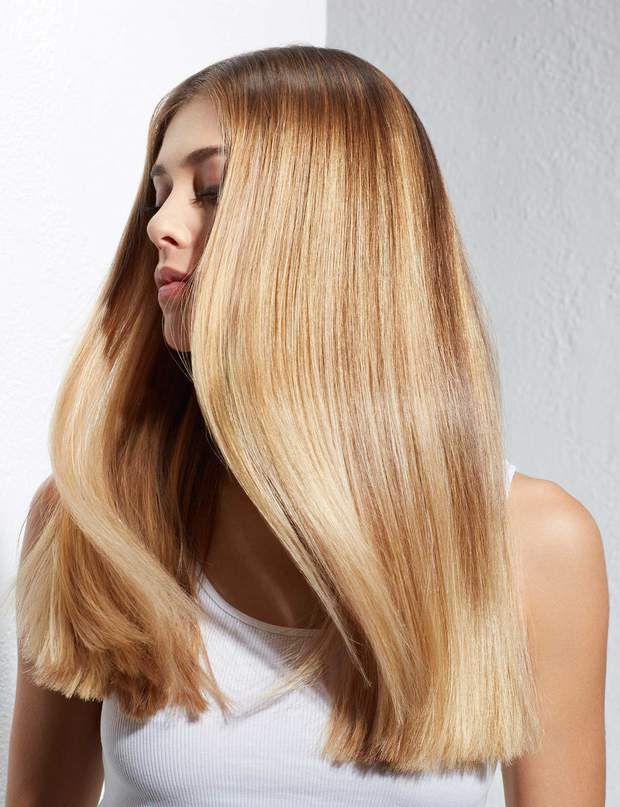Beauty...

By Marissa DeSantis
No matter what your go-to hue, there’s something about that fresh-from-the-salon hair color that just hits differently. Sure, the color itself is more vibrant and dimensional, whether you leave the salon with a head of blonde highlights or an all-over copper or rich brunette color. But there’s also that shiny, super-smooth finish, which leaves hair looking and feeling instantly healthier—and never quite seems to be able to be replicated at home after the first wash. That’s where a hair gloss comes in.
The temporary treatments that are typically applied in the salon, are also available for at-home use. But before you reach for the gloss, there are a few things you’ll want to know when it comes to what exactly they can achieve and how to choose the right gloss for your hair color. Ahead, we spoke with Mark DeBolt, co-founder of Mark Ryan Salon and celebrity colorist, for the how-to on at-home hair glosses.
“A gloss is an application of a semi-permanent color, usually after a color service, that adds shine, depth, and tone,” DeBolt explains. Depending on the formula that’s used, a hair gloss (or hair glaze, the two are the same thing, FYI) can amplify certain tones, correct brassiness, and restore shine to the hair. “After a lightening service, we may apply a gloss to add a baby-blonde hue, or glosses can be used to refresh a redhead or add depth to a brunette,” DeBolt says.
Hair glosses also come in clear formulas that don’t change the color at all but still provide conditioning benefits and add shine.
Though hair glosses may sound like little miracle workers (and they kind of are), it’s important to note that they are non-permanent color treatments. That means if you’re looking to make a color switch-up or cover your grays, only a visit to your colorist (or a box dye if you’re brave) will help.
DeBolt says that ideally, you should speak with your colorist first for product suggestions or even a custom gloss (your colorist will know your hair needs best, after all). “I’ll send clients home with tinted conditioners to apply to gloss their hair at home,” he explains, adding that he’s able to provide specific instructions for how to apply the treatment and how often to use it. “If you are purchasing something over-the-counter, I recommend opting for a clear gloss,” DeBolt advises. “This will add great conditioning and shine without the risk of changing the color.”
If you do opt for an at-home color gloss, do your research, and above all else, steer clear of lightening products. “Avoid anything that claims to lighten the hair or contains lightening agents like peroxide, which can lead to brassy, orange sections or uneven color results,” DeBolt stresses.
“DpHUE has some great products that got my clients through during the salon shutdown,” DeBolt says of the brand’s Gloss+ line, which comes in 10 color options in addition to their clear gloss formula. DeBolt also names the Christophe Robin Shade Variation Mask line as another favorite. “The Cool Brown Mask subdues brassy tones beautifully, and the Baby Blonde refines blonde hair without making it too dull or building up a gray, flat pigment on the hair.”
DeBolt’s biggest tip for using an at-home hair gloss may seem like an obvious one, but it’s also crucial when it comes to getting the right results: Follow the instructions on the label. “These products are formulated differently, and for best results, it’s important to follow the directions on the package,” he says. For example, the processing time (or the amount of time the gloss is left on the hair) varies between brands, and even how you apply it (on wet vs. dry hair) can differ.
In addition to thoroughly reading the directions prior to using your gloss, many brands have also shared how-to videos on YouTube. DeBolt’s go-to, dpHUE, has a quick breakdown on how to use their gloss, while celebrity stylist Kristin Ess offers a series of step-by-step tutorials for her Signature Hair Gloss line, from mixing the formula to effectively saturating the hair. Then, there are brands like Madison Reed and L’Oreal’s new Color & Co, which offer virtual consultations with colorists to help ensure the most seamless results.
Because these are conditioning, semi-permanent color treatments, you don’t want to overdo it on the gloss.
“I recommend using a hair gloss at home about every month,” DeBolt says.
But again, be sure to check the manufacturer’s recommendation for a specific timeline.